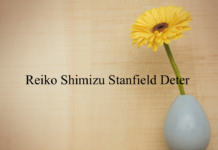Tony Glover, Cullman County Extension
It is often said that if you do not like the weather here in Alabama just wait a little while because it will soon change. Fall is a favorite time of year for many people, including myself- not just because of the cooler temperatures, but also because of the beautiful fall colors.
Most people assume cooler temperatures will increase the chances for a beautiful array of fall foliage colors. Temperatures do play a role, but fall foliage color is really quite complicated and not easy to predict. According to United States National Arboretum, a wet growing season followed by a dry autumn filled with sunny days and cool, frostless nights results in the brightest palette of fall colors. If this were accurate, I would expect the fall colors to be very nice this year. Changes in weather can speed up, slow down or change the arrival time of fall’s colorful foliage.
You may think that a tree’s “true” color is green, but actually most deciduous species begin to show their “true” colors in autumn. According to the National Oceanic and Atmospheric Administration, here is why: “The four primary pigments that produce color within a leaf are: chlorophyll (green); xanthophylls (yellow); carotenoids (orange); and anthocyanins (reds and purples). During the warmer growing seasons, leaves produce chlorophyll that cause plants to create energy from light. Almost all life on earth is dependent on this process. This green pigment becomes dominant and usually masks the other pigments.”
Trees must replenish the chlorophyll because sunlight causes it to fade over time. As days get shorter and nights become longer, trees prepare for winter and the next growing season by blocking nutrient and mineral flow to and from a leaf’s stem. This process stops green chlorophyll from being replenished and causes the leaf’s green color to fade.
The fading green allows a leaf’s “true” colors to emerge, producing the dazzling array of orange, yellow, red and purple pigments we refer to as fall foliage.
The other critical factor is the species of tree because it has to have the “true” colors that are pleasing to look at. There are many great trees that produce consistently pleasing fall colors that should be planted more frequently in Alabama. Listed here are three of my favorites. Why not plant in your landscape this fall? Remember fall and winter are the best months to plant trees and shrubs.
- The Black Gum tree (Nyssa sylvatica) is a wonderful native species that tolerates a wide range of soil types, has beautiful red fall color, provides a good nectar source for bees, and the female trees produce a small fruit that birds enjoy.
- The Ginkgo tree (Ginkgo biloba) has the most beautiful vivid yellow fall color of any tree that can be grown in Alabama. It has other great qualities as well including being a very tough tree that can tolerate poor soils. However, I do not recommend planting seedling trees because the fruit of female trees stink terribly. For that reason I suggest you plant male trees that are vegetatively propagated to be absolutely certain you do not get any fruit development.
- Sourwood (Oxydendrum arboretum) is a native tree most commonly found on rocky wooded slopes in the Appalachian Mountains, often growing in combination with other heath family members (e.g., azaleas and rhododendrons) that share the same acidic soil preferences. In cultivation, it typically grows 20-25’ tall with a straight, slender trunk and narrow oblong crown. Bees love this native tree and you will to. Plant where they will have afternoon shade and morning sun. It has the most vivid red fall color of any native species in the South.
For those of us in north Alabama we have the opportunity to enjoy fall color at a higher level than those in far south Alabama. If you have been stuck in your house all summer, I hope you can get out when the leaves start to change. I lived in Dekalb County at one time and I can attest that the drive between Cullman and the Little River Canyon area is particularly beautiful and makes for a great day trip in the fall.


























